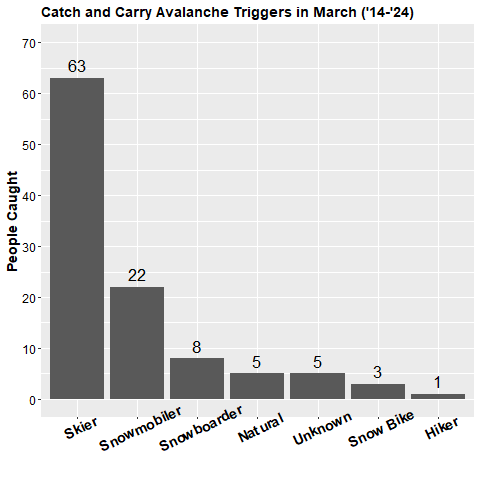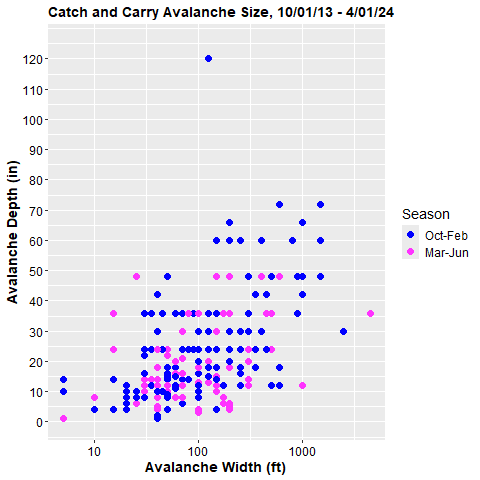
McKinley Talty
Education Manager
Remember Warren Miller’s famous quote, “If you don’t do it this year, you’ll be one year older when you do”? I like to think Warren meant to say, ‘If you don’t do it this spring, you’ll be one year older when you do.’ Spring is a coveted season in the backcountry, and typically, it’s the time of year to go after bigger objectives. As the days become longer and lingering weak layers trend dormant, the avalanche problems often become more manageable. In this perception of safety, however, we continue to see riders getting caught and carried in avalanches. In March 2024, fourteen people were caught in avalanches across Utah, accounting for 40% of all catch-and-carry avalanches this season. This season isn’t an anomaly, either.


Over the past 10 seasons, more people have been caught in an avalanche during March than any other month. Thanks to the UAC’s new Observations Explorer page, I pulled data on the types and sizes of these avalanches to see if there were any noticeable differences between October-February and March-June.

It’s evident that the types of avalanches catching riders vary between early and late season, but the sizes of these avalanches seem to stay consistent. The reported depths of avalanches that have caught riders are only slightly deeper during October-February compared to March-June, while the reported widths of these avalanches remain similar.


So is the avalanche danger similar between Oct-Feb and Mar-Jun? The graph below shows avalanche danger ratings in the SLC region between October 2018 and April 2024. While danger ratings issued in December, January, and February are fairly similar, there’s a clear difference once March comes around. Fewer High / Considerable hazard days and more Moderate / Low hazard days exist after February, but we see an increase in riders caught in avalanches, and these avalanches aren’t getting smaller. It’s impossible to read minds in the backcountry, but could a heuristic factor be at play during the spring months? Maybe it’s the lure of long sunny days, maybe it’s the lack of persistent weak layers, maybe it’s decision fatigue after a long winter. The data, however, shows that while conditions are generally safer late in the season, we must stay vigilant whenever we’re in the mountains. We all have systems for planning days in the backcountry, checking our gear, continuously observing the snowpack throughout the day, and communicating with our partners. Keeping these systems in place until we hang up our boots at the end of the year can help fight complacency and fatigue after a long winter. Let’s treat every day in the backcountry with the same respect, no matter the time of year.

Love the data curation on this one, very insightful. Thanks McKinley, see you out there!
Erik Fullmer (not verified)
Thu, 4/4/2024
- reply






